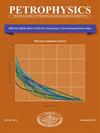Enhanced Reservoir Description via Areal Data Integration and Reservoir Fluid Geodynamics: A Case Study From Deepwater Gulf of Mexico
IF 0.7
4区 工程技术
Q3 ENGINEERING, PETROLEUM
引用次数: 0
Abstract
Accurate reservoir characterization is vital for effective decisions made throughout the life cycle of an oilfield reservoir, including management and development. Of all the components of reservoir description, hydraulic connectivity carries the highest amount of uncertainty, where inaccurate connectivity evaluation often results in production underperformance. Shortcomings are faced when applying conventional approaches of connectivity assessment. Seismic surveys are not always sufficient to evaluate lateral connectivity as detected faults can be transmissive or partially transmissive, while some faults are below the detection limits of seismic amplitude measurements. Vertical connectivity represents another uncertainty, where pressure measurements and well logs are often either unable to detect the baffles along oil columns or cannot assess whether detected baffles are relevant seals or flow diverters. Although conventional downhole fluid analysis (DFA) workflows have proven effective in delineating reservoir connectivity, enough DFA data are not always available, and with added complexity, uncertainties arise. Additionally, while equilibrated asphaltene gradients, measured through DFA probes, imply connectivity, ongoing reservoir fluid geodynamics (RFG) processes, such as current hydrocarbon charging, can preclude equilibration in a connected reservoir. Thus, a comprehensive assessment approach, that utilizes all available data streams, is needed to overcome the significant spatial complexity associated with moderately and heavily faulted reservoirs. In this paper, we employed our recently introduced interpretation workflow to evaluate the connectivity of a heavily faulted reservoir in the deepwater Gulf of Mexico. The field was divided into five investigation areas penetrated by 12 wells. Areal downhole fluid analysis (ADFA) was applied to assess local connectivity leading to reservoir-scale connectivity. Through integrating fluid/dynamic and rock/static data, each data type provided insights that were pieced together to enhance consistency and reduce uncertainty. Analyzed data included pressure-volume-temperature (PVT) reports, pressure surveys, well logs, and geochemistry. The study resulted in a verifiable connectivity description where faults, previously regarded as sealing, were classified into sealing or partially transmissive faults; unresolved faults were detected. Fault-block migration was detected, and fault throw was estimated; asphaltenes behavior was used to deduce original field structures prior to faulting. We also examined RFG processes to investigate oil biodegradation, where an asphaltene clustering trend was observed, causing high oil viscosities toward the bottom of one sandstone. A correlation was then derived and successfully implemented to estimate oil viscosity.基于区域数据集成和储层流体地球动力学的储层描述:以墨西哥湾深水为例
准确的油藏特征对于油藏整个生命周期(包括管理和开发)的有效决策至关重要。在油藏描述的所有组成部分中,水力连通性具有最大的不确定性,其中不准确的连通性评估通常会导致生产表现不佳。传统的连通性评估方法存在不足。地震调查并不总是足以评估横向连通性,因为检测到的断层可能是透射性的或部分透射性的,而有些断层低于地震振幅测量的检测极限。垂直连通性是另一个不确定因素,压力测量和测井通常无法检测到沿油柱的挡板,或者无法评估检测到的挡板是否与密封或分流有关。尽管传统的井下流体分析(DFA)工作流程在圈定储层连通性方面已被证明是有效的,但并不总是有足够的DFA数据可用,而且随着复杂性的增加,不确定性也会出现。此外,虽然通过DFA探针测量的平衡沥青质梯度意味着连通性,但正在进行的储层流体地球动力学(RFG)过程,如当前的油气充注,可能会阻碍连通储层的平衡。因此,需要一种综合评估方法,利用所有可用的数据流,克服与中度和重度断层油藏相关的显著空间复杂性。在本文中,我们采用了最近引入的解释工作流程来评估墨西哥湾深水一个严重断裂油藏的连通性。该油田分为5个调查区,共12口井。区域井下流体分析(ADFA)用于评估局部连通性,从而获得油藏规模的连通性。通过整合流体/动态和岩石/静态数据,每种数据类型都提供了拼凑在一起的见解,以增强一致性并减少不确定性。分析的数据包括压力-体积-温度(PVT)报告、压力测量、测井和地球化学。该研究得出了一个可验证的连通性描述,其中以前被认为是封闭性的断层被划分为封闭性或部分传输性断层;检测到未解决的错误。检测断块偏移,估计断层落差;沥青质的行为被用来推断断裂之前的原始油田结构。我们还研究了RFG过程,以研究石油的生物降解,其中观察到沥青质聚集趋势,导致一个砂岩底部的石油粘度很高。然后推导出一个相关性,并成功地用于估计油的粘度。
本文章由计算机程序翻译,如有差异,请以英文原文为准。
求助全文
约1分钟内获得全文
求助全文
来源期刊

Petrophysics
地学-地球化学与地球物理
CiteScore
1.80
自引率
11.10%
发文量
40
审稿时长
>12 weeks
期刊介绍:
Petrophysics contains original contributions on theoretical and applied aspects of formation evaluation, including both open hole and cased hole well logging, core analysis and formation testing.
 求助内容:
求助内容: 应助结果提醒方式:
应助结果提醒方式:


